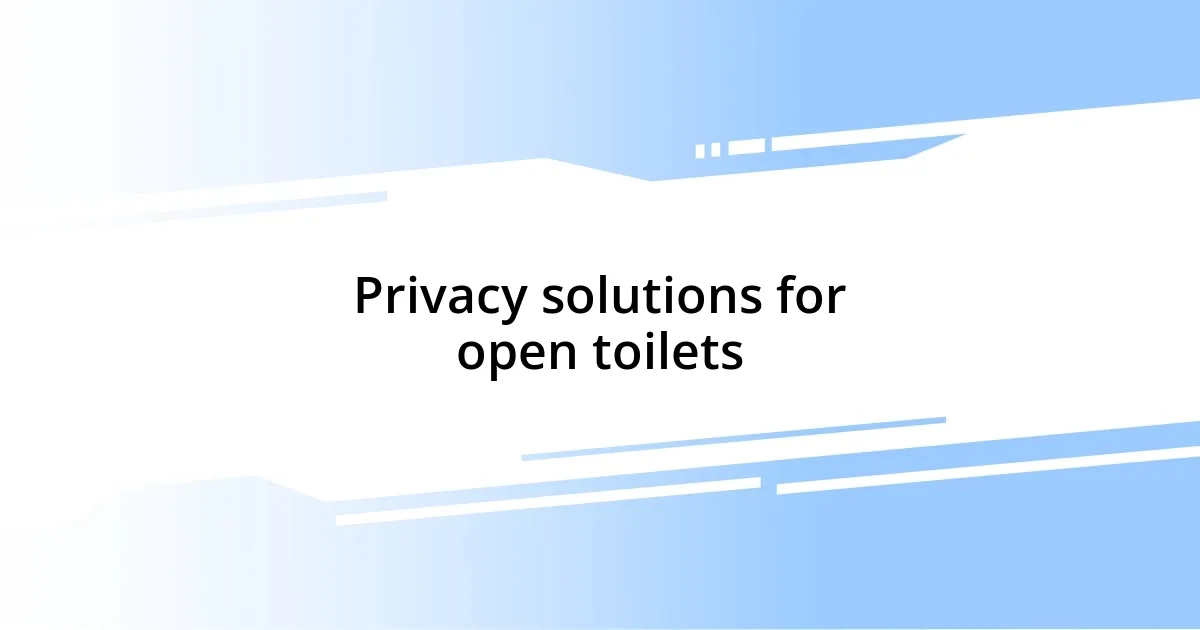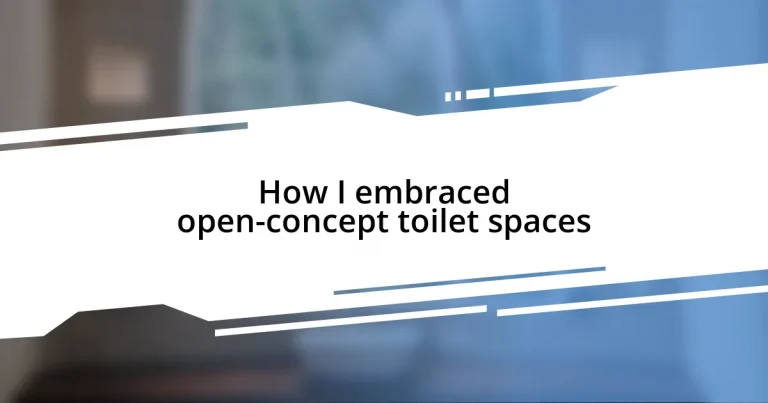Key takeaways:
- Open-concept toilets enhance natural light and create a welcoming atmosphere, promoting interaction and connection within households.
- Design principles such as maximizing natural light, ensuring clear pathways, and using cohesive colors enhance the fluidity and functionality of open spaces.
- Creative privacy solutions, like curtains and plants, can maintain intimacy without sacrificing the open concept aesthetic.
- Personalizing the space with color palettes, decor, and sensory elements can transform the toilet area into a relaxing sanctuary.

Understanding open-concept toilets
Open-concept toilets represent a modern shift in bathroom design, blending functionality with an airy, spacious feel. I remember my initial skepticism when I first encountered one in a friend’s home. The thought of being in such proximity to the rest of the living space felt strange—didn’t privacy matter? However, after experiencing it firsthand, I noticed how it transformed the overall flow of the area and allowed for more natural light, creating a welcoming atmosphere.
In essence, this design breaks down traditional barriers, both physically and socially. I often found myself wondering: could this open layout foster communication and connection within a household? Indeed, in my experience, the lack of doors led to lighthearted banter while someone was in the shower, making mundane moments feel more intimate and shared.
Open-concept toilets often raise eyebrows, but they symbolize a shift toward embracing transparency in our living spaces. For many, this concept can be liberating; it encourages a more relaxed environment where family members feel comfortable and connected. I’ve found that the emotional weight often tied to the bathroom can dissipate in such settings, leading to a more laid-back, communal vibe. Isn’t it interesting how our physical spaces can shape our emotional experiences?

Benefits of open-concept bathrooms
Open-concept bathrooms provide a sense of spaciousness that traditional designs often lack. When I transitioned to one, I felt an immediate lightness, as if the room itself had expanded. I distinctly recall one morning when the sun streamed in through the windows, illuminating everything—it was a strangely uplifting moment.
Another remarkable benefit I’ve experienced is the enhanced interaction with loved ones. When my kids are playing nearby, I never feel isolated while attending to my needs. Instead of a hard barrier, there’s this seamless connection that makes it easier to remain involved in family activities—even during the middle of a shower.
I also appreciate the practicality that comes with open-concept bathrooms. Cutting down on walls means less upkeep and maintenance, allowing me to spend more time enjoying my space. I remember how a simple clean-up became so much faster, with just a quick wipe down rather than maneuvering around tight corners. Overall, these bathrooms foster an atmosphere where function marries aesthetics beautifully.
| Benefit | Details |
|---|---|
| Spaciousness | Creates an airy, inviting environment that feels larger. |
| Enhanced Interaction | Encourages connection with family, making everyday moments more special. |
| Practicality | Simplifies upkeep, allowing you to enjoy your space more fully. |

Design principles for open spaces
When designing open-concept toilet spaces, it’s essential to prioritize fluidity and functionality. I learned quickly that a cohesive color palette can unify the different areas, creating an effortless flow from one space to another. A memorable evening I had involved preparing for a gathering; I realized how the coordinated colors made everything feel like part of a larger, harmonious experience—an extension of our home instead of isolated rooms.
To achieve this, consider the following design principles:
- Natural Light: Maximize window placements or opt for frosted glass to ensure privacy while letting in sunshine.
- Visual Connection: Use similar floor materials throughout the spaces to maintain cohesion and visual interest.
- Clear Pathways: Ensure there are unobstructed lines of sight that guide people through your area, enhancing the feeling of openness and accessibility.
- Strategic Furnishing: Select furniture that complements the open space, avoiding bulky pieces that disrupt flow.
- Texture and Layering: Incorporate varied textures—like soft textiles or smooth surfaces—adding warmth without compromising the airy feel.
Each of these elements fosters an environment that feels both expansive and inviting, which is something I wholeheartedly embraced in my own home.

Choosing the right materials
Choosing the right materials for an open-concept toilet space is a game changer. I remember the moment I decided on porcelain tiles over vinyl; the porcelain’s cool touch and sleek finish added a touch of elegance that transformed the space. Did you know that choosing non-porous materials can also make cleaning a breeze? I’ve found that it saves me time, allowing me to focus on more enjoyable activities.
It’s crucial to think about color and texture too. For instance, I opted for soft, muted tones in my materials to create a tranquil atmosphere. The subtle hues evoke calmness, especially when paired with natural elements like wooden accents. I often find myself escaping to this serene environment after a long day, and the materials truly set the tone for relaxation.
Additionally, consider the practicality of your choices. I chose water-resistant wall coverings that not only reflect my style but also withstand humidity. It’s a small decision that pays off immensely; I’ve already avoided potential mold issues, and that peace of mind is priceless. So, what materials will you select to enhance both style and functionality in your space?

Privacy solutions for open toilets
When it comes to privacy solutions for open toilets, I discovered that creative partitioning can be both stylish and functional. A beautiful screen I found at a local artisan market not only adds a visual barrier but also serves as a stunning focal point in the room. Every time guests comment on it, I’m reminded that privacy doesn’t have to sacrifice aesthetics—it can be a charming conversation starter too.
One very effective approach I took was installing curtain tracks along the ceiling. This way, I can draw soft curtains when I want a bit of seclusion. What I love about this solution is its flexibility; when I’m hosting a casual get-together, I can easily pull them back to enhance openness. This dual functionality has allowed me to create a feel of privacy without the expense of a full wall, giving me a sense of comfort without compromising the open concept flow.
Another solution I’ve embraced is the use of plants for natural screening. I filled one corner with tall, leafy greens that double as décor and a privacy shield. I’ve found myself standing there, soaking in the tranquility, surrounded by nature, all while feeling shielded from view. Isn’t it fascinating how the right plants can transform a space, fostering both intimacy and a connection to the outdoors?

Maintenance tips for open layouts
Maintaining an open layout requires a bit of strategy, but I’ve picked up some valuable tips along the way. I often create a regular cleaning schedule, setting aside time each week to tackle the space. This consistency keeps things feeling fresh, and I’ve noticed that when I devote just a small amount of time to upkeep, I avoid overwhelming messes later on. Have you ever felt that dread when trying to tackle a neglected area? I know I have!
In my experience, investing in multifunctional furniture can be a lifesaver for organization, especially in an open-concept toilet space. For instance, I added a sleek, under-sink storage unit that not only keeps essentials out of sight but also complements the overall style of the room. This little change has made it so much easier to maintain order—who knew that a small adjustment could have such a massive impact on both function and aesthetics?
I can’t stress enough how important ventilation is in these spaces, especially to combat humidity. I opted for a stylish exhaust fan that actually adds to the decor rather than detracts from it. Proper airflow has not only helped me keep mold at bay but also made the environment feel more inviting. How do you think the airflow in your space affects your overall comfort? I firmly believe that it can make or break one’s experience in an open layout.

Personalizing your open toilet space
Personalizing my open toilet space has truly been a journey of self-expression. I decided to choose a color palette that resonates with my personality—soft pastels and earthy tones—that creates a serene vibe. When I walk in, I feel instantly relaxed, almost like I’m stepping into a peaceful sanctuary. Have you ever noticed how colors can influence your mood? It’s a small change that makes a big difference for me.
One of the most rewarding aspects of this personalization process was curating a selection of art and decor that speaks to my interests. I hung up framed prints of my favorite nature scenes, and even a few quirky bathroom-themed quotes. Every time I catch a glimpse of them, I can’t help but smile. It’s like bringing a little piece of my personality into an often-overlooked space. What types of decor spark joy for you? Finding that perfect balance between whimsy and elegance has truly turned my toilet space into a reflection of who I am.
Adding personal touches like scented candles and custom-made towels has transformed the atmosphere. I remember when I first placed a few candles on a floating shelf; their flickering warmth created a cozy ambiance that elevated the entire experience. It’s amazing how such small details can create an inviting space where I can unwind. How would you describe the feeling in your toilet area? To me, it should always feel like an oasis, regardless of the layout.














